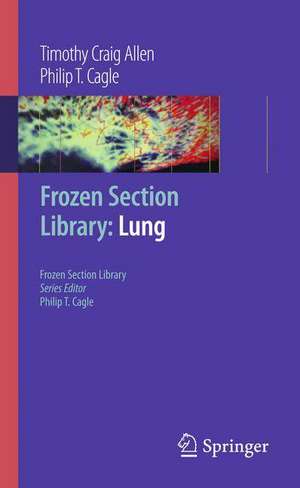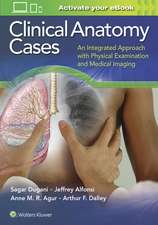Frozen Section Library: Lung: Frozen Section Library, cartea 1
Autor Timothy Craig Allen, Philip T. Cagleen Limba Engleză Paperback – 17 noi 2008
The Frozen Section Library series will provide convenient, user-friendly handbooks for each organ system to expedite use in the hurried frozen section situation. These books will be small and light-weight, copiously color illustrated with images of actual frozen sections, highlighting pitfalls, artifacts and differential diagnosis. These books will also include perspectives for the surgeon and for communication with the surgeon and suggest ancillary procedures (for example, when to take tissue for microbiology cultures). Each 5 X 8 book is estimated to be about 200 to 250 pages in toto with 100 to 150 color figures each.
As a handbook for practicing pathologists, these books will be indispensable aids to diagnosis and avoiding dangers in one of the most challenging situations that pathologists encounter. Problems, such as differentiation of benign processes from malignant neoplasms which may be more difficult on frozen section than permanent section and which have a serious impact on the surgeon’s immediate treatment decisions, will be emphasized. Rapid consideration of differential diagnoses and how to avoid traps caused by frozen section artifacts will be readily accessible to the users of the handbooks. A series of concise, easy-to-use, well-illustrated handbooks alleviates the often frustrating and time-consuming, sometimes futile, process of searching through bulky textbooks that are unlikely to illustrate or discuss pathologic diagnoses from the perspective of frozen sections in the first place. Tables and charts will provide guidance for differential diagnosis of various histologic patterns.
The advantages of a series of organ-specific handbooks, in addition to the ease-of-use and manageable size, is that (1) it allows more comprehensive coverage of more diagnoses, both common and rare, than a single volume that tries to highlight a limited number of diagnoses for each organ and (2) it allows more detailed insight by permitting experienced authorities to emphasize the peculiarities of frozen section for each organ system. Although some differences in practice of frozen section exist between different institutions, such as differing policies regarding whether or not to perform frozen section on specific types of specimens, these differences are generally not significant and can be discussed ( an organ-specific handbook by an expert in that organ system permits more opportunity for this type of discussion). Touch preparations, which are used for some organs such as central nervous system or thyroid more often than others, will be appropriately emphasized and illustrated according to the need for each specific organ.
This series will be highly valuable to practicing surgical pathologists, both community and academic, and to pathology residents and fellows. The perspectives provided will also be valuable to surgeons and especially to surgery residents and fellows who must answer questions about pathology and frozen section on their board examinations. These handbooks will be easily portable by the individual but it is envisioned that many departments will want to also keep a series readily available in the frozen section laboratory.
| Toate formatele și edițiile | Preț | Express |
|---|---|---|
| Paperback (2) | 769.28 lei 6-8 săpt. | |
| Springer Us – 19 mar 2010 | 831.50 lei 3-5 săpt. | |
| Springer – 17 noi 2008 | 769.28 lei 6-8 săpt. |
Preț: 769.28 lei
Preț vechi: 809.77 lei
-5% Nou
147.22€ • 152.09$ • 122.52£
Carte tipărită la comandă
Livrare economică 25 martie-08 aprilie
Specificații
ISBN-10: 0387095721
Pagini: 131
Ilustrații: XI, 131 p.
Dimensiuni: 127 x 203 x 8 mm
Greutate: 0.18 kg
Ediția:2009
Editura: Springer
Colecția Springer
Seria Frozen Section Library
Locul publicării:New York, NY, United States
Public țintă
Professional/practitionerCuprins
Benign Proliferations Versus Cancer.- Primary Cancers of the Lung.- Metastases to the Lung.- Surgical Margins.- Benign Focal Lesions.- Wedge Biopsy for Diffuse Lung Diseases.- Lymph Nodes.
Recenzii
"This is a succinct, pocket-sized book filled with color images of actual frozen sections of lung specimens … . It will benefit community and academic practicing surgical pathologists, as well as pathology residents and fellows. In addition, it provides useful perspectives to surgeons performing the surgeries which rely on frozen section diagnosis. … This is the first of a series dedicated entirely to the practice of frozen section diagnosis. … a welcome addition to the library of any pathologists who performs frozen sections." (Maura F. O’Neil, Doody’s Review Service, April, 2009)
Textul de pe ultima copertă
Frozen sections are performed while a patient is undergoing surgery as a basis for making an immediate diagnosis that will impact treatment decisions. Frozen section diagnosis is often a highly demanding situation for the pathologist who must render a diagnosis quickly for the patient and surgeon.
The Frozen Section Library series will provide concise, user-friendly, site specific handbooks that are well illustrated and highlight the pitfalls, artifacts and differential diagnosis issues that arise in the hurried frozen section scenario.
Timothy Craig Allen, MD, JD, is the Chairman of the Department of Pathology, University of Texas Health Science Center at Tyler, Tyler, Texas.
Philip T. Cagle, MD, is Professor of Pathology, Weill Medical College of Cornell University, New York and Director of Pulmonary Pathology, The Methodist Hospital, Houston, Texas.
Descriere
Frozen sections are performed for the purpose of rapid diagnosis while a patient is undergoing surgery, usually under general anesthesia, as a basis for making immediate treatment decisions. Therefore, frozen section diagnosis is often a highly demanding situation for the pathologist who must render a diagnosis quickly and a crucial determination for the patient and surgeon. In addition to the need for rapid recall of differential diagnoses, there are many pitfalls and artifacts that add to the risk of frozen section diagnosis that are not present with permanent sections of fully processed tissues that can be examined in a more leisurely fashion. Most standard pathology textbooks, both general and subspecialty, largely ignore the topic of frozen section. Few textbooks have ever focused exclusively on frozen section diagnosis and those textbooks that have done so are now out-of-date and have limited numbers of black and white figures. None has emphasized the education of the surgeon in terms of frozen section benefits, limitations or proper utilization.
The Frozen Section Library series will provide convenient, user-friendly handbooks for each organ system to expedite use in the hurried frozen section situation. These books will be small and light-weight, copiously color illustrated with images of actual frozen sections, highlighting pitfalls, artifacts and differential diagnosis. These books will also include perspectives for the surgeon and for communication with the surgeon and suggest ancillary procedures (for example, when to take tissue for microbiology cultures). Each 5 X 8 book is estimated to be about 200 to 250 pages in toto with 100 to 150 color figures each.
As a handbook for practicing pathologists, these books will be indispensable aids to diagnosis and avoiding dangers in one of the most challenging situations that pathologists encounter. Problems, such as differentiation of benign processes from malignant neoplasms which may be more difficult on frozen section than permanent section and which have a serious impact on the surgeon’s immediate treatment decisions, will be emphasized. Rapid consideration of differential diagnoses and how to avoid traps caused by frozen section artifacts will be readily accessible to the users of the handbooks. A series of concise, easy-to-use, well-illustrated handbooks alleviates the often frustrating and time-consuming, sometimes futile, process of searching through bulky textbooks that are unlikely to illustrate or discuss pathologic diagnoses from the perspective of frozen sections in the first place. Tables and charts will provide guidance for differential diagnosis of various histologic patterns.
The advantages of a series of organ-specific handbooks, in addition to the ease-of-use and manageable size, is that (1) it allows more comprehensive coverage of more diagnoses, both common and rare, than a single volume that tries to highlight a limited number of diagnoses for each organ and (2) it allows more detailed insight by permitting experienced authorities to emphasize the peculiarities of frozen section for each organ system. Although some differences in practice of frozen section exist between different institutions, such as differing policies regarding whether or not to perform frozen section on specific types of specimens, these differences are generally not significant and can be discussed ( an organ-specific handbook by an expert in that organ system permits more opportunity for this type of discussion). Touch preparations, which are used for some organs such as central nervous system or thyroid more often than others, will be appropriately emphasized and illustrated according to the need for each specific organ.
This series will be highly valuable to practicing surgical pathologists, both community and academic, and to pathology residents and fellows. The perspectives provided will also be valuable to surgeons and especially to surgery residents and fellows who must answer questions about pathology and frozen section on their board examinations. These handbooks will be easily portable by the individual but it is envisioned that many departments will want to also keep a series readily available in the frozen section laboratory.
Caracteristici
Concise Handbook
Site Specific























